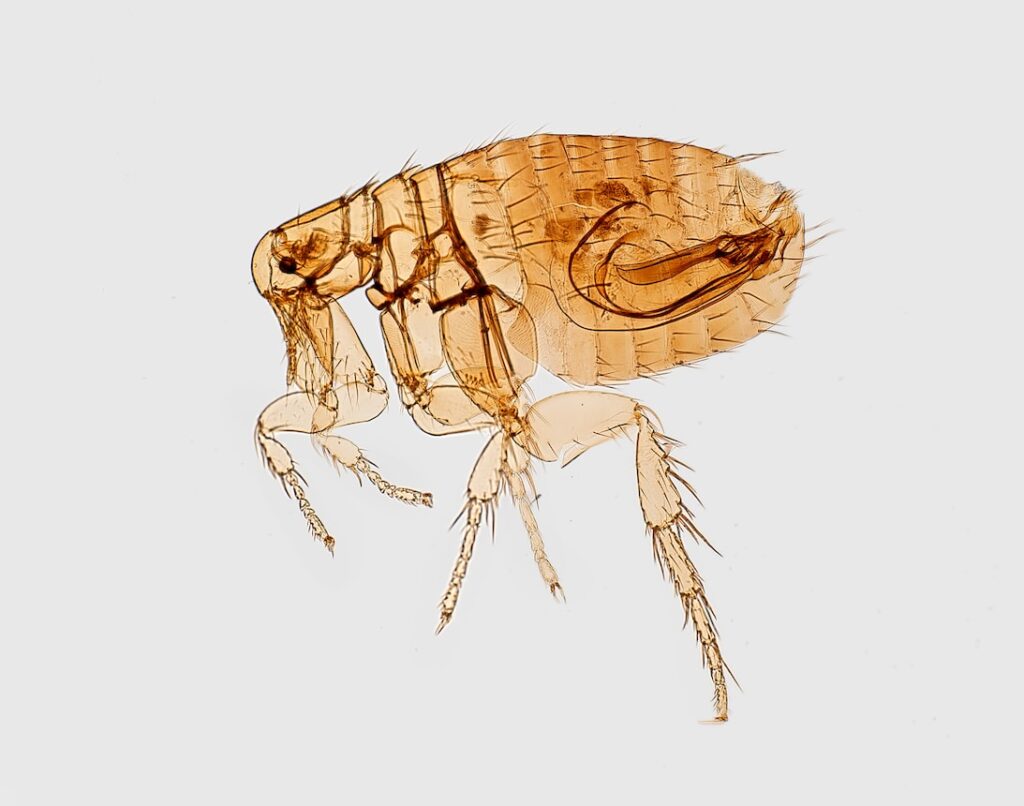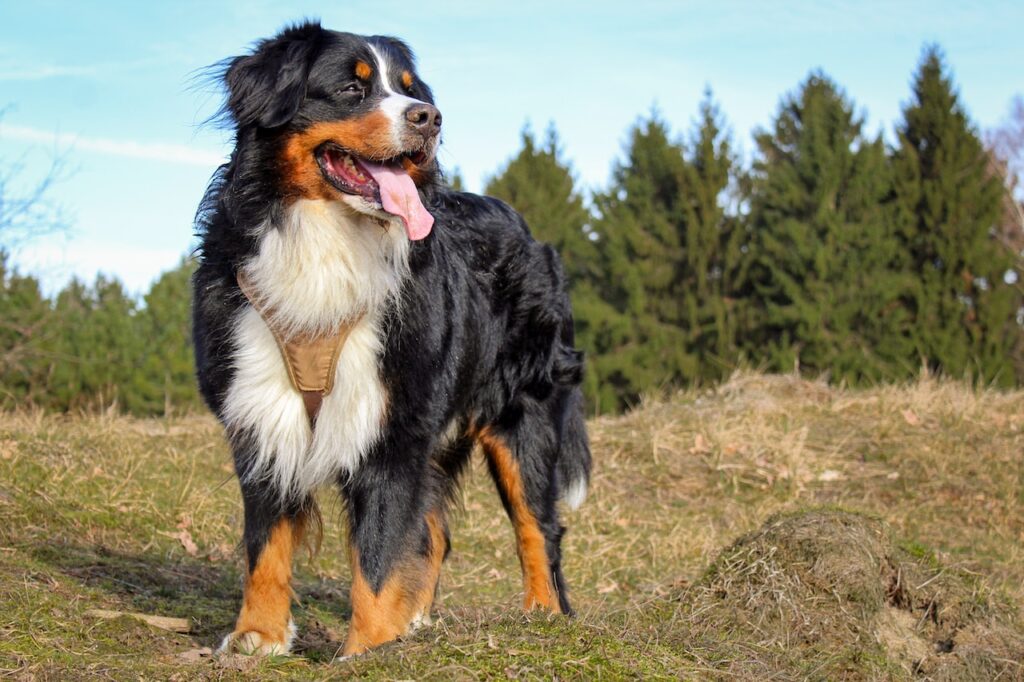Fleas are tiny bugs that bite and bother your dog. They make the skin itchy, and red and sometimes cause hair loss. But , How to know if dog has fleas?
If your dog has lots of fleas, it can get sick. Fleas can give your dog worms and cause allergies. Keep your dog healthy by spotting and getting rid of fleas!
Read if dogs can eat Tomatoes.
Table of Contents

How to know if dog has fleas?
Fleas usually hang out in nature, like in grass and bushes. But sometimes, they end up in our homes, waiting for a chance to jump on a host. These tiny bugs are about three millimeters long and have an incredible jumping ability—up to one meter wide and 25 centimeters high!
Fleas are brown, flat, and don’t have wings. They belong to the insect family and have six legs. Their long hind legs give them the power to jump far. To protect themselves, fleas have a tough body made of chitin, like armor.
Thousands of flea species exist worldwide. The ones that concern us are the dog flea, cat flea, and the human flea. The most common flea found on dogs is the cat flea, not the dog flea. The names don’t always match the hosts!
Can people transmit dog fleas?
If a dog has a lot of fleas or isn’t around, the fleas might jump onto humans. However, humans are not their first choice; we are like temporary hosts, called “false hosts,” for a short time.
The reproduction and spread of fleas is rapid
After a female flea has its first blood meal, it can lay between 27 to 50 eggs daily on your dog. These eggs are smooth and fall off, ending up in places like grass or your carpet. They wait for the right conditions to hatch: around 25°C and 80% humidity. In about a week, larvae hatch and hide in dark places like sofa cracks or deep in carpets, pupating in a cocoon.
About 10 days later, they sense warmth, increased CO2, and vibrations from a potential host. They jump out, and attack dogs, cats, or even people, starting the cycle again. Fleas can also spread from one dog to another, but they prefer staying with their hosts for survival. Hedgehogs can also be carriers.
Even if there are only ten fleas on your dog , there can be up to 500 eggs per day, and soon larvae everywhere – in carpets, dog baskets, upholstery, pillows, and textiles. Larvae can survive for up to six months without a blood meal.
In apartments, especially with multiple animals, a flea invasion can happen and become hard to control. It’s better to take precautions early and act immediately at the first sign of a flea problem!
Beware of fleas in winter and use these tips to stop them.
Fleas often look for warmth in homes during the cold season, brought in by wild animals to places like cellars, attics, or sheds. Even in winter, it’s important to protect your dog from flea infestations. Natural spot-on treatments shield your dog for about four weeks, while flea collars protect for approximately five months. If your dog is already dealing with fleas, a flea powder can help get rid of them.
Don’t forget to treat the surroundings, like your dog’s sleeping area, with pest sprays to prevent fleas from returning. It’s crucial to follow up with a worm treatment for your dog because fleas can transmit worms. If the flea problem persists, it’s best to consult with a vet.

How to recognize fleas on your dog
The first sign of a flea infestation in your dog is intense itching caused by the saliva of biting fleas, leading to persistent scratching. Some dogs may even bite or nibble on the affected areas.
Detecting a flea infestation isn’t always easy. Not every dog scratches enough for the owner to notice, and in dogs with thick fur, finding fleas can be a matter of luck. Even if the infestation is small, you might not see the fleas, which can have serious consequences if it leads to a larger invasion later on!
To check if your dog has fleas, use a simple test:
- You need a so-called flea comb – a fine, narrow-toothed special comb – and a damp, light-colored cloth or kitchen roll.
- Comb the dog’s fur against the direction of growth and then tap the comb on the damp cloth.
- If you see black-brown particles, crush them on the damp cloth.
- If the dark crumbs turn rusty brown to reddish or if a red ring forms around the crumb, then this is flea excrement (digested blood), which the fleas excrete after their blood meal. The flea larvae also feed on these droppings.
- If the dark particles do not change color, they are normal dirt from your dog’s fur.
Where do fleas like to sit on dogs?
Fleas can bite a dog anywhere on its body during a severe flea infestation. You can identify them by noticing several spaced bites, which form what we call a “flea ladder.” Dogs often have these on areas where the skin is thinner, like around the ears, the stomach, or the inside of the legs.
Stopping the Flea Circus:
Recognizing the Issue:
When you notice a mild flea problem on your dog, it likely indicates a much larger infestation in your pet’s surroundings. Researchers suggest that only 5% of fleas live on the host, with the remaining 95% existing as eggs, larvae, and pupae in the environment.
Understanding the Challenge:
Treating the dog alone with preventive measures like collars or spot-on treatments might make fleas leave your dog, but they stay in the surroundings, ready to return. The focus should extend beyond the dog to tackle the entire environment.
Step One: Tackling Adult Fleas and Offspring:
In the case of an existing flea issue, effective veterinary preparation is necessary. Use insecticides like special shampoos, flea powders, and sprays to eliminate adult fleas. Additionally, employ an insect development inhibitor to destroy eggs. Repeated application at specified intervals is crucial. Seek veterinary advice due to the toxicity of these substances, and treat all animals in your household.
Can a Shower Help?
While a thorough shower can wash away some fleas from your dog, it’s only partially effective since most fleas are in the environment. To permanently eliminate fleas, medical flea treatment is essential.
Step Two: Eradicating Flea Breeding in the Environment:
To break the flea development cycle, the entire environment must be free of fleas. Take strict measures like daily wet mopping, vacuuming, and disposing of dust bags. Wash textiles at high temperatures, treat dog’s lying surfaces and textiles with anti-flea powder, and use room sprays to eliminate fleas, eggs, and larvae. Repeat these actions for at least three months.
Step Three: Prevention is Key:
To avoid complex and costly measures, prioritize preventive actions alongside flea treatment. Administer antiparasitics like spot-ons or flea collars parallel to the flea treatment. Choose a drug with a repellent or knock-down effect to prevent fleas from biting. Seek veterinary advice for safe and effective options.

Dealing with Fleas: Home Remedies and Caution
Addressing Acute Infestations:
When facing a sudden flea problem on your dog, home remedies alone might not be sufficient for effective control. However, they can complement medical treatment and serve as prevention against future infestations.
Coconut Oil – a Natural Deterrent:
Coconut oil is a well-known home remedy for fleas on dogs. Its unpleasant scent for fleas, mites, and other parasites makes it a natural deterrent. The lauric acid in coconut oil can break down the protective chitin shell of fleas. Rubbing your dog with coconut oil can help prevent flea infestations.
Neem Oil – Chemical-Free Solution:
Another chemical-free remedy is Neem oil, derived from the seeds of the Asian neem tree. Used in Ayurveda for medicinal purposes, Neem oil can calm and disinfect existing bites and act against parasites. Be aware that the strong smell of Neem oil may be unpleasant for your dog’s sensitive nose.
Important Note:
Before using home remedies, always consult your veterinarian. They can guide the effectiveness and safety of these remedies for your specific situation.
Flea Facts:
Fleas are tiny but troublesome creatures. They bite, scratch, cause itching, and can lead to allergies. Fleas can also carry tapeworms and are not hesitant to bother humans. Taking preventive measures and seeking professional advice can help keep your dog flea-free and healthy.
Fleas spread diseases – here’s what you can do!
Fleas can carry a tapeworm called cucumber seed tapeworm, and if a dog bites or swallows an infected flea, it can get this tapeworm. So, it’s important to treat for worms after dealing with fleas!
The saliva from flea bites during a blood meal can lead to a serious allergy in some dogs, known as flea dermatitis. This is more likely to happen if the flea problem is severe. Treating fleas is crucial to prevent allergic reactions in dogs.
Symptoms of a flea allergy can include:
Signs of Flea Troubles in Dogs:
- Frequent and Intense Scratching:
Your dog may scratch a lot, trying to relieve discomfort.
- Sore Skin and Swelling:
Areas of the skin may become sore, and there might be swelling.
- Hair Loss in Specific Areas:
Loss of hair, particularly on the back, hind legs, or at the tail’s base.
- Redness and Skin Changes:
Look out for “Hot spots,” which are red and irritated skin areas, especially at the back’s base and inside the hind legs.
- Red Puncture Points:
You might notice red spots surrounded by reddened areas.
- Extreme Cases – Personality Changes:
In severe situations, dogs may exhibit personality changes like nervousness, anxiety, or aggressiveness due to intense itching and painful inflammation. Early flea intervention can help prevent these issues.
Therapy for flea allergy
The most crucial step is using specialized veterinary medication to combat fleas on the dog and in its surroundings. Preventive measures like spot-on treatments or flea collars are effective only when they have a repellent effect.